Application Hosting on Catalyst Access Points White Paper
Available Languages
Bias-Free Language
The documentation set for this product strives to use bias-free language. For the purposes of this documentation set, bias-free is defined as language that does not imply discrimination based on age, disability, gender, racial identity, ethnic identity, sexual orientation, socioeconomic status, and intersectionality. Exceptions may be present in the documentation due to language that is hardcoded in the user interfaces of the product software, language used based on RFP documentation, or language that is used by a referenced third-party product. Learn more about how Cisco is using Inclusive Language.
Wireless networks are a rapidly growing part of today's technology, and at this moment in history, we as a society are more connected than ever before. Through a joint global effort, once-complex problems can now be solved with simple yet elegant solutions. However, in recent years, as the world's population has rapidly grown in size, we have begun to face a whole new set of issues that require technology to resolve. These pain points vary greatly and range from the need to effectively manage thousands of retail stores in order to meet rising global demands to the challenge of monitoring massive protected natural areas to prevent further degradation. While each global pain point has its own set of complexities, a single common denominator affects each issue. That is the immense difficulty of effectively managing anything of massive scale. For example, with regard to protection of natural areas, unless helicopters can patrol the area night and day, without technology, there is no way to ensure that the environment is not disturbed further. The same goes for retail stores and their ability to assure the same quality of service that is achievable through e-commerce. Unless large teams of employees are physically there to support both store operations and customers 24/7, competitive challenges will certainly be present.
Clearly, with the surge of technology and growth in human population, the traditional management methods used for hundreds of years have lost their effectiveness. We're at a point in time when we need a clear path to manage the exponentially scaling world. The Internet of Things (IoT) can help meet this need.
The IoT can be described as the ability to leverage a wireless network to monitor and transfer data through smart devices, automatically and without human intervention. With regard to environmental rehabilitation, we can deploy sensors in the areas we'd like to monitor. Through smart IoT software, we can automate the entire process of detecting environmental anomalies and monitoring large expanses of land from a single computer screen. The same concept applies to retail stores, where we can replace the standard price tags with electronic shelf labels. Through smart IoT software, we can not only manage inventory in multiple stores at once but also provide a stellar customer experience with the ability to locate items from a mobile application. To spearhead this technological revolution, Cisco has created a state-of-the-art platform known as Application Hosting on Catalyst® Access Points.
Cisco’s Application Hosting on Catalyst Access Points feature provides users with the ability to load third-party Dockerized Cisco® IOx applications directly onto Cisco Catalyst access points and to leverage them as IoT gateways. Once loaded, the third-party application gains complete access to specific access point software and hardware resources. Depending on the application developed, it can have the ability to communicate with a third-party application server through its internal VLAN, or with third-party IoT devices wirelessly through an IoT USB connector. Giving third-party developers the ability to create applications and leverage these access points as IoT gateways has created endless possibilities for the IoT movement.

Overview of Application Hosting on Catalyst Access Points
Cisco’s goal for Application Hosting is to enable anyone with the desire to innovate in the field of IoT to leverage Cisco Catalyst access points as a platform. The software development workflow used by Cisco’s engineering teams for Application Hosting is incredibly straightforward and systematic. By using Cisco’s DevNet page, which gives a step-by-step walkthrough of the process, any developer can go from software planning to developing in a matter of minutes.
To further understand the IoT application planning and development workflow, refer to our official DevNet page (https://developer.cisco.com/app-hosting-ap) and Figure 2 below.
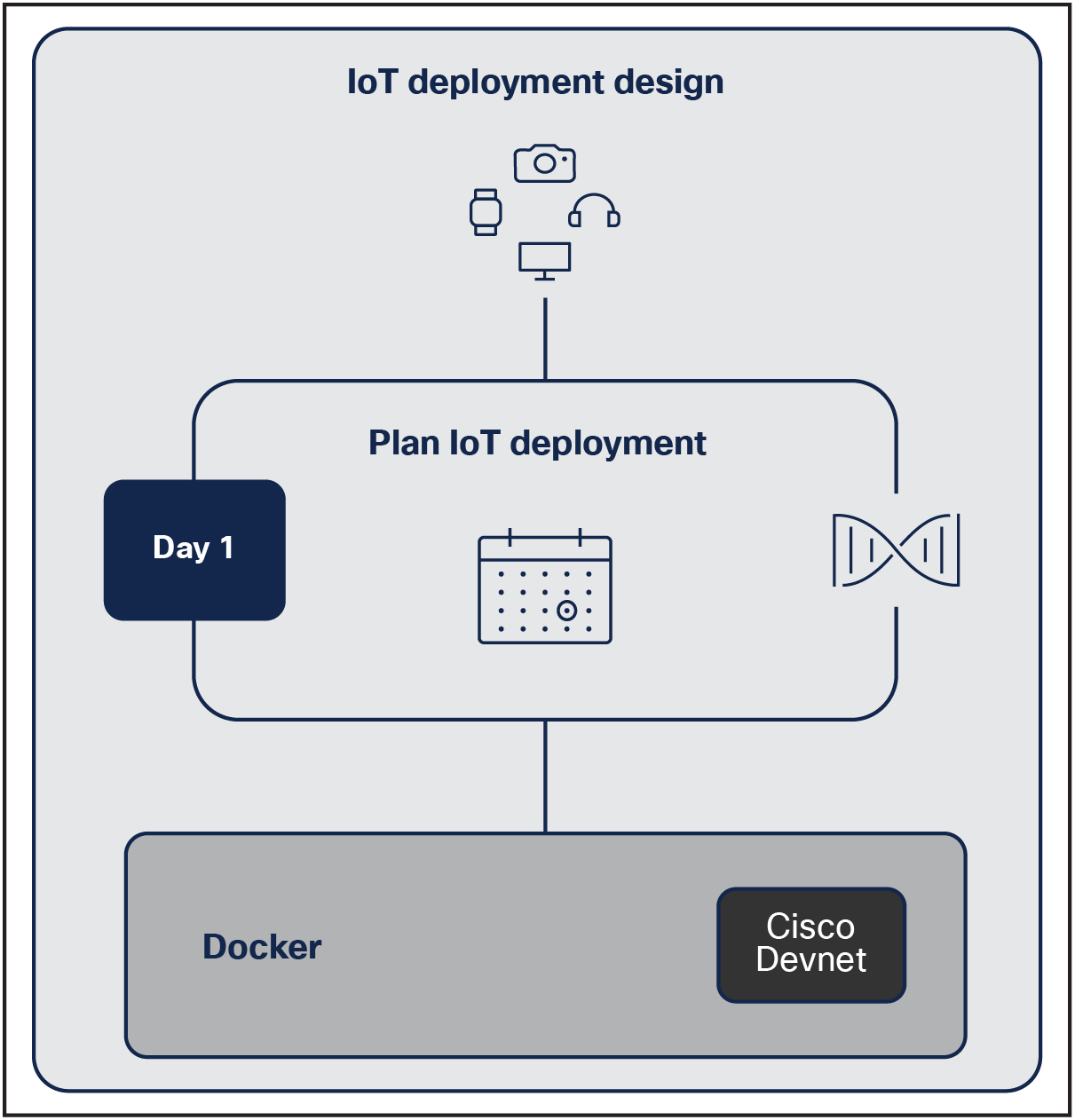
Application planning and development workflow
High-level deployment workflow
To allow smooth deployment of an application to an organization’s access points, we have created an intuitive four-step process that enables users to set up Cisco Catalyst Center and begin reaping the benefits of IoT with minimal effort. Cisco’s ultramodern intent-based networking platform, Cisco Catalyst Center, provides users with a well-designed user interface to quickly and easily deploy the application and manage its lifecycle.
To further understand the application deployment workflow, refer to the diagram and steps below.
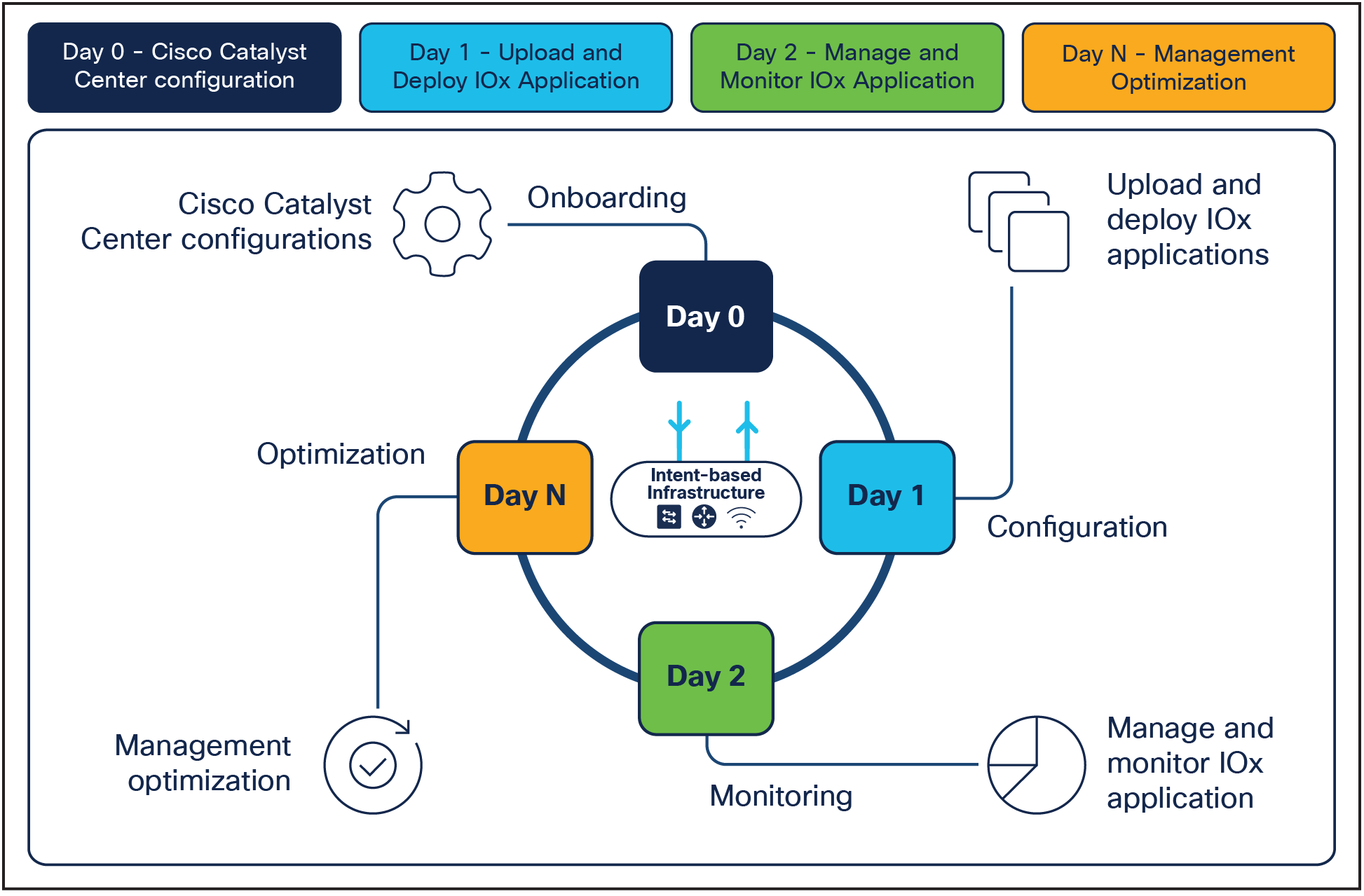
Application Hosting deployment workflow
Day 0: Cisco Catalyst Center configurations
Note: Skip to day 1 if you have already completed day-0 Cisco Catalyst Center configuration.
1. Create a network hierarchy site (area, building, floors) via the Network Hierarchy page.
2. Optional: Configure the Network Hierarchy settings via the Network Settings page.
3. Discover the WLC and access points via the Discovery page.
4. Assign the WLC and access points to the network hierarchy created via the Inventory page.
Day 1: Upload and deploy IOx applications
1. Upload a third-party IOx application to Cisco Catalyst Center via the IoT Services page.
2. Deploy the uploaded application to specific access points.
Day 2: Manage and monitor IOx applications
1. Establish communication between the third-party application and its third-party application server.
2. Begin managing and monitoring the applications deployed on the access points.
Day N: Optimize management optimization
1. Validate how the deployed applications are performing in the field.
2. Develop software enhancements based on analysis, and upgrade your applications.
3. Repeat the deployment workflow from day 1.
The state-of-the-art Application Hosting technology is built directly into the Catalyst access point code itself. Other than the optional requirement of adding an IoT USB connector to the access point's USB module, no additional change to a wireless deployment is required. The application-loaded access point takes on the role of an IoT gateway and acts as a middleman that enables a third-party application server to communicate with IoT devices surrounding the access point’s physical location.
Application Hosting works by enabling the application to begin communicating, through the access point's internal management VLAN, with a cloud or on-premises third-party application server. The application server can then leverage each access point as its own IoT gateway and talk to the surrounding IoT devices through the access point's IoT USB connector. Since typical wireless deployments have access points deployed throughout each employee-inhabited facility, Application Hosting can easily enable control of IoT devices throughout multiple regions at once.
To further understand the general topology of an Application Hosting deployment, refer to the figure below.
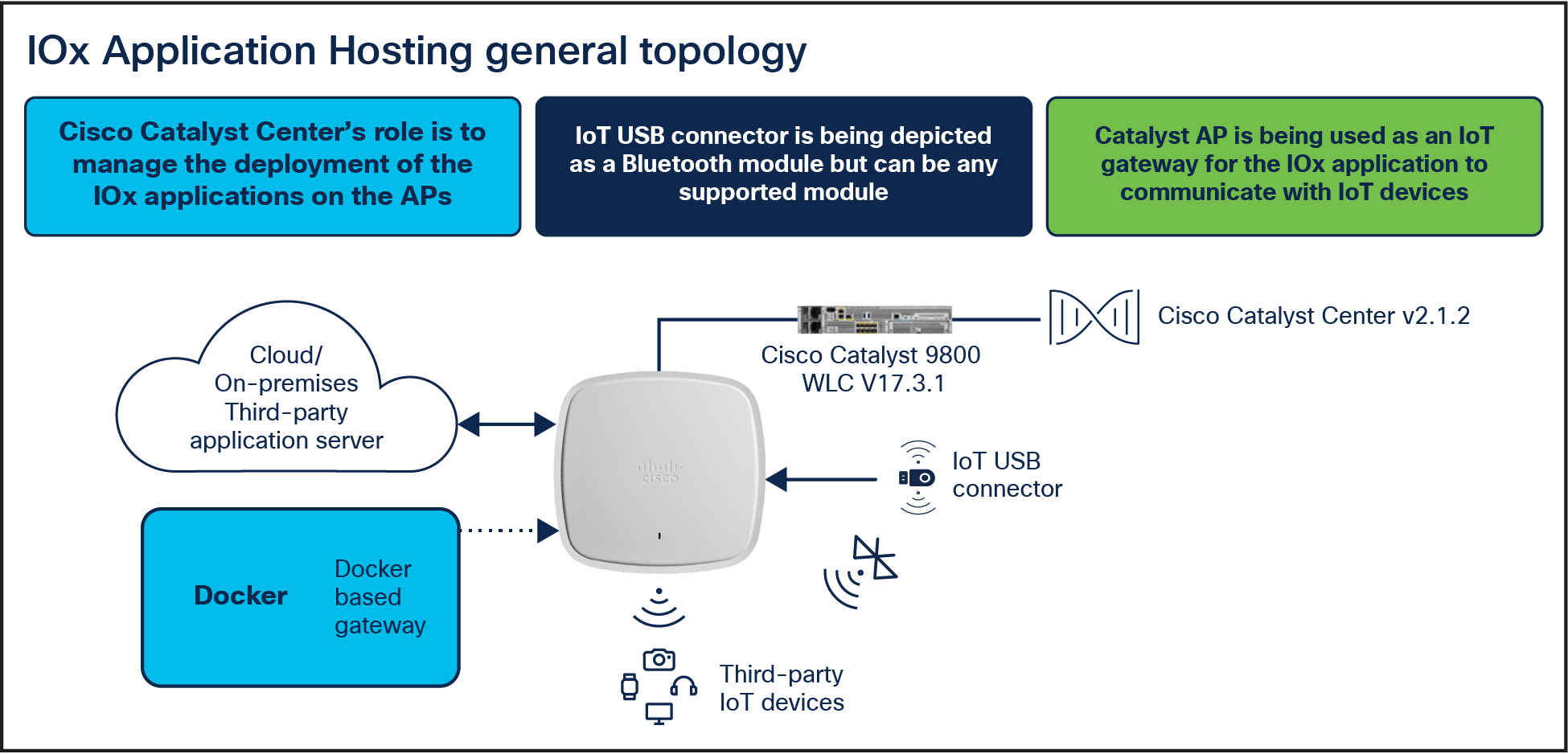
Application Hosting general topology
To allow developers to focus on creating incredible IoT applications with quick turnaround time, Application Hosting has been designed in a way that removes all irrelevant hardware constraints, giving developers the freedom to code without worrying about the underlying infrastructure. For example, a deployed application can easily communicate externally through a Network Address Translation (NAT) provided IP address received automatically through the Dynamic Host Configuration Protocol (DHCP) server from the access point’s control plane. This design allows all deployed applications to effortlessly and securely communicate with anything they need to in the network. Another example is that by allowing direct HTTPS communication between each access point and Cisco Catalyst Center, a developer can quickly deploy their developed applications throughout their entire network for validation, without any downtime.
To further understand the network topology of an Application Hosting deployment, refer to the figure below.
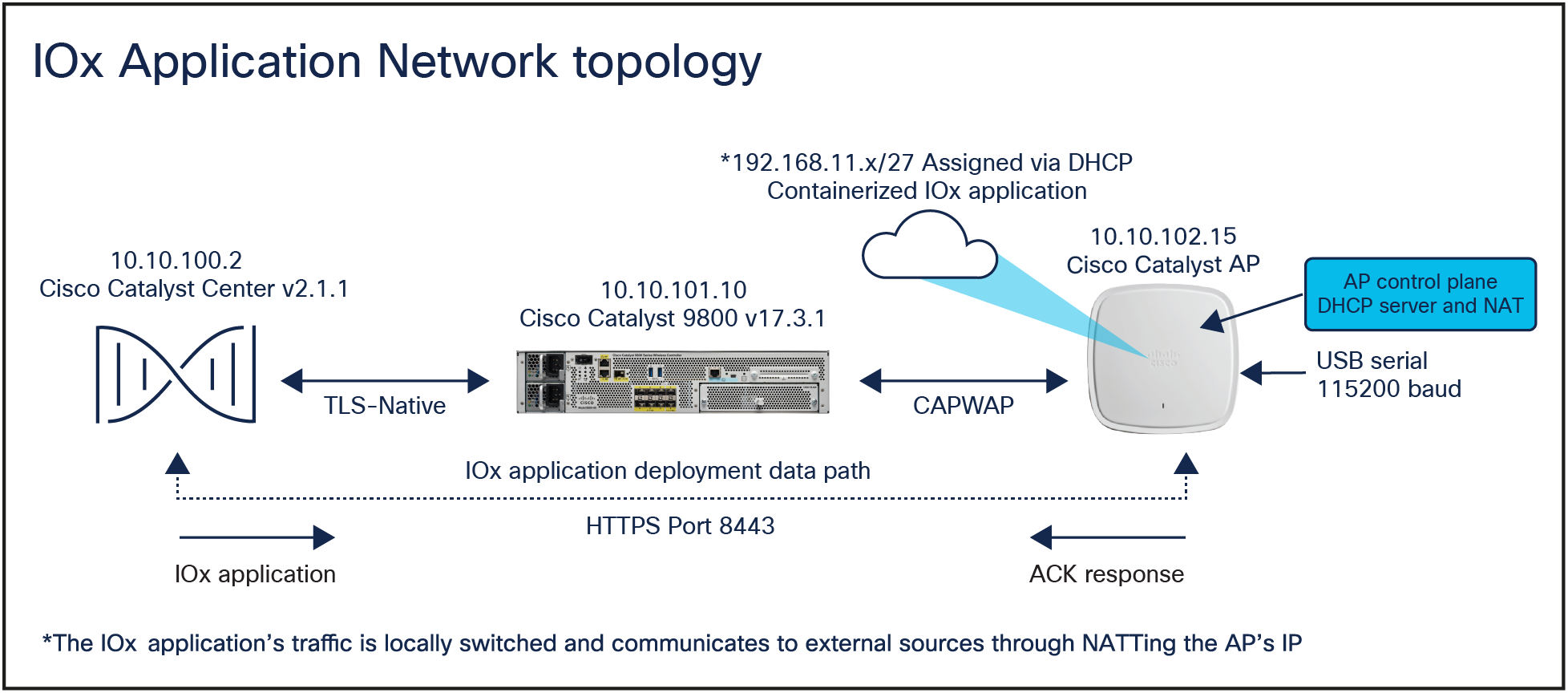
Application Hosting network topology
Cisco’s Application Hosting on Catalyst Access Points feature provides endless possibilities to developers working in the IoT. This section offers some ideas for use cases as inspiration.
Use case 1: Healthcare
Background: A pandemic hit the world in 2020, caused by a virus identified as COVID-19. Due to its contagious nature, the virus has caused devastating effects throughout the globe.
Pain points: Individuals must be quarantined immediately due to the incredibly contagious nature of the virus. The contagiousness of this virus has caused immense impacts on both patients’ well-being and medical facilities’ ability to manage operations.
How Application Hosting can address the pain points: With Application Hosting, you can create applications that respond to external stimuli such as voice control devices (i.e., Google Home, Amazon Echo).
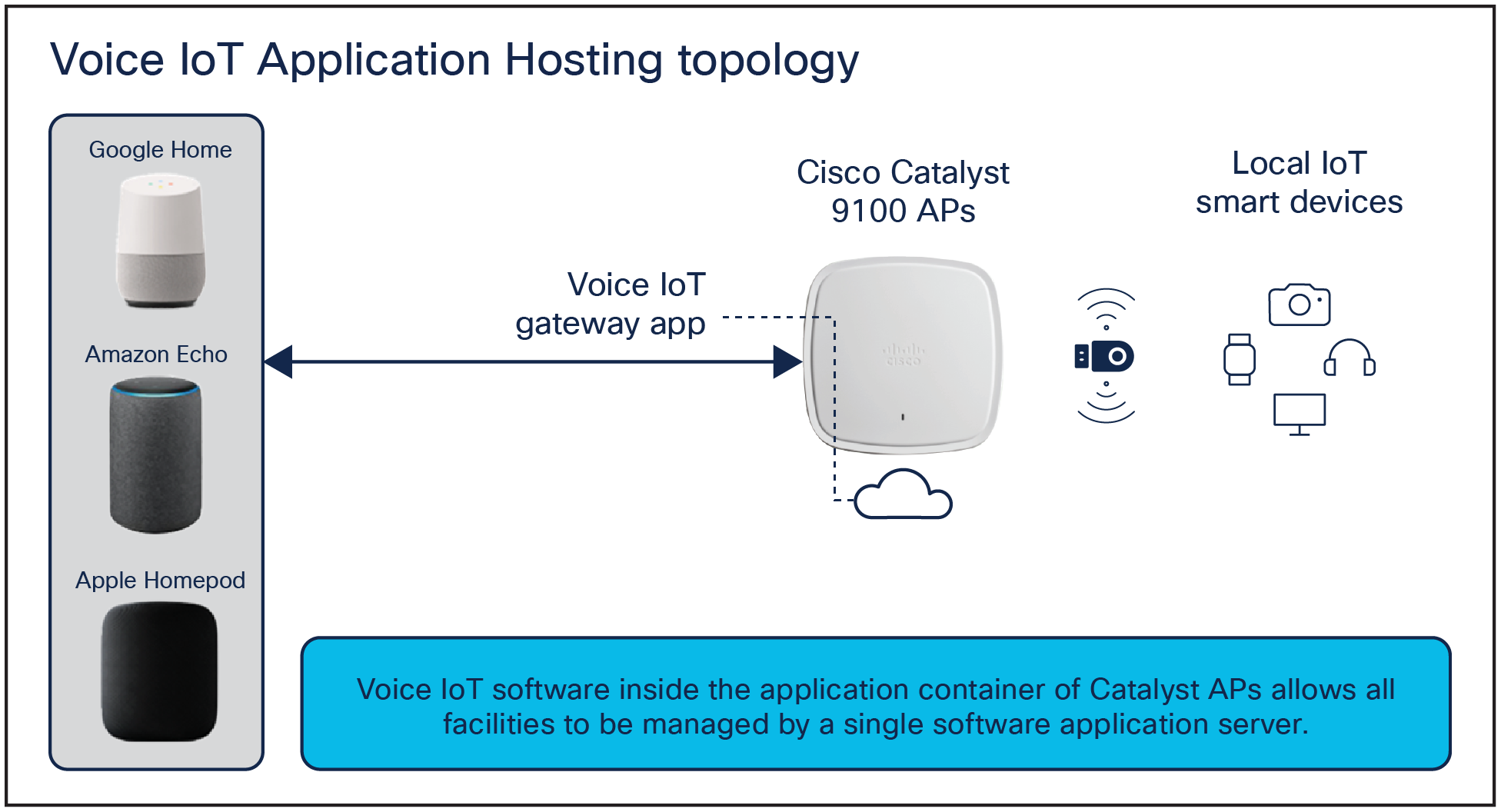
Voice IoT software topology
Your application can use these received external parameters to trigger actions such as calling for a nurse, changing the temperature, adjusting the bed, and many more. Such technology increases the convenience of bedridden patients and helps medical facility staff maintain maximum effectiveness while social distancing during the COVID-19 pandemic.

Patients leveraging Cisco IoT technology to control devices through voice
To further understand how Application Hosting can revolutionize the world of healthcare, refer to the figure below.
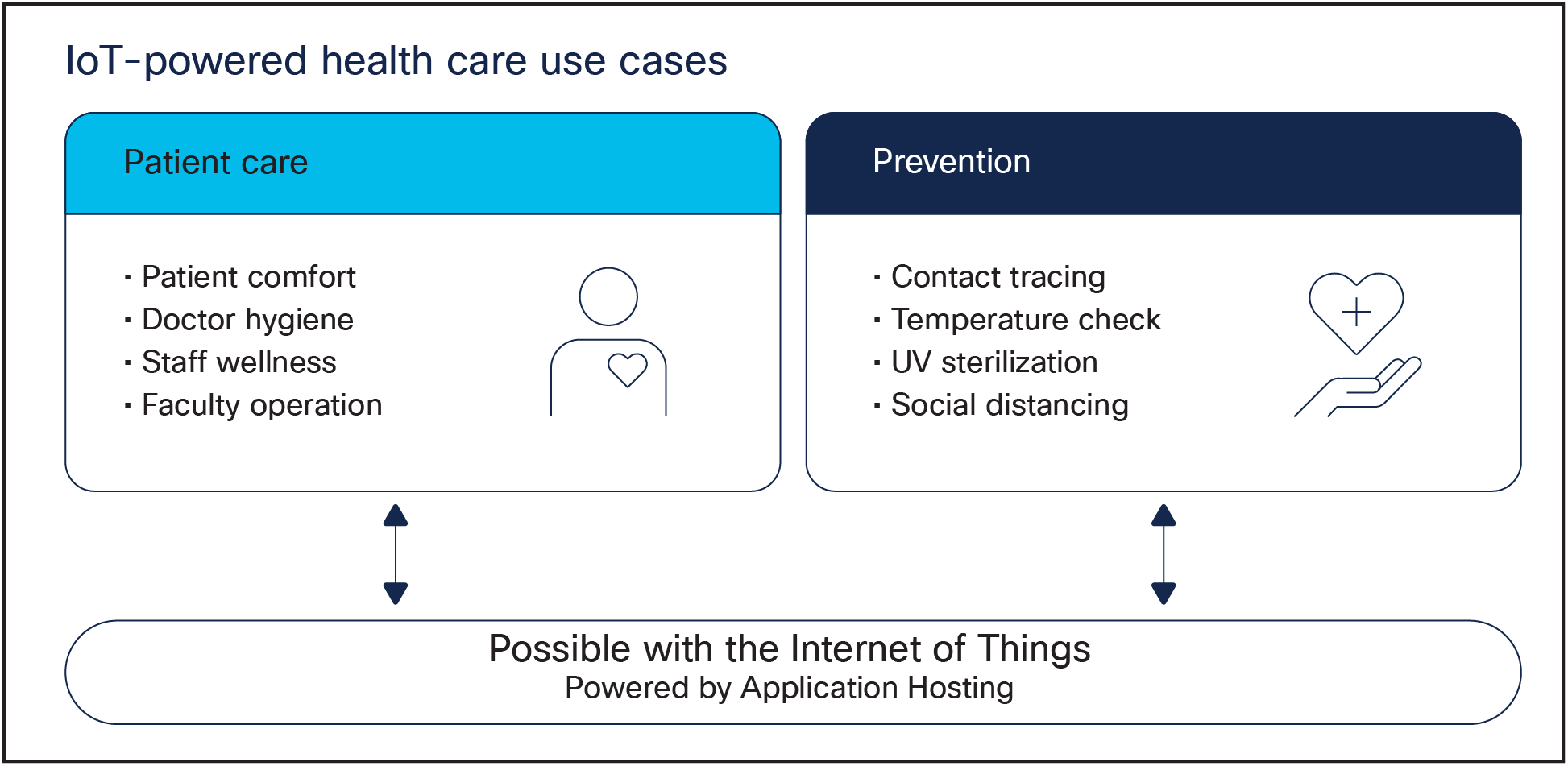
Application Hosting healthcare use cases
Use case 2: Building management system (BMS)
Background: A sizable multiregional enterprise is looking for smarter ways to manage facilities spread through multiple countries.
Pain points: Managing these facilities and ensuring 24/7 security can be a difficult task. Often a large team of facilities managers must be onsite to ensure employees’ safety and security. Such a manual process drains a company financially and leaves security vulnerable to potential human error.
How Application Hosting addresses the pain points: With Application Hosting, you can create applications that directly communicate with smart building management devices throughout all facilities in multiple regions at once.
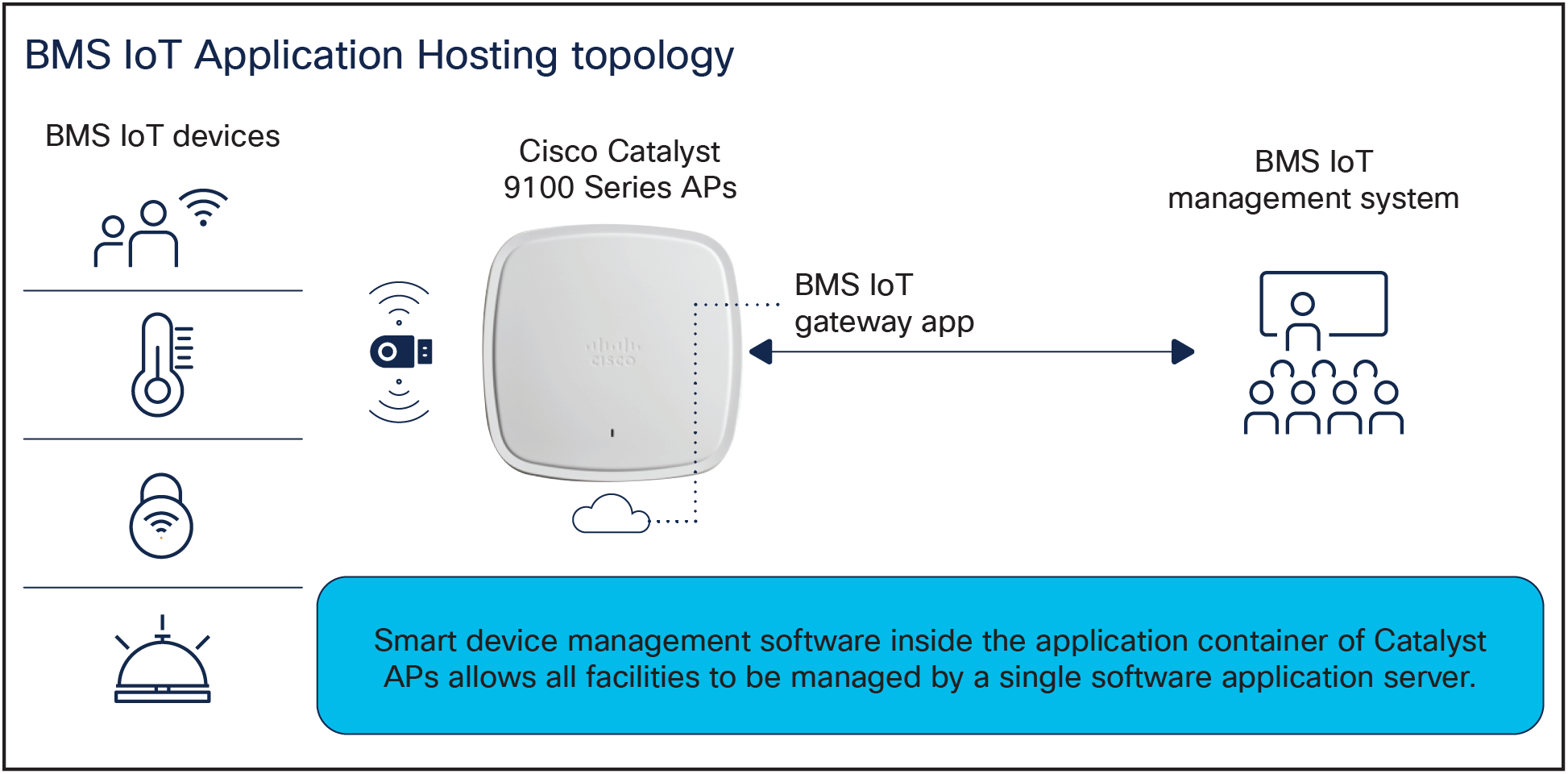
Smart devices communicating with a BMS manager through Catalyst APs
You can automate all devices to report information back to a central application server, creating a convenient command center for facilities management. What once required a large team of facilities managers can now be accomplished with intelligent IoT software.
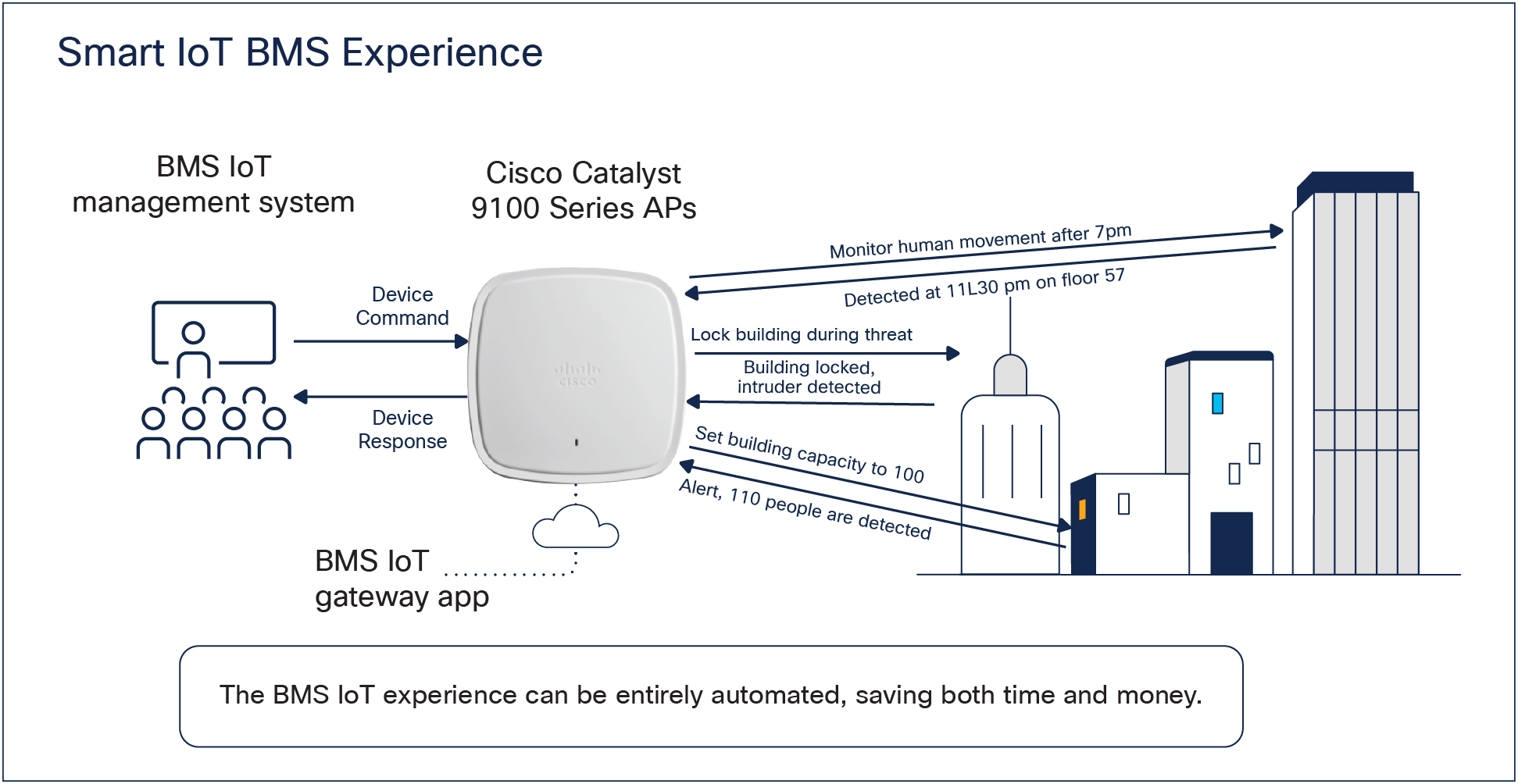
Using Application Hosting to monitor multiple buildings
To further understand how Application Hosting can modernize the building management system, refer to the figure below.
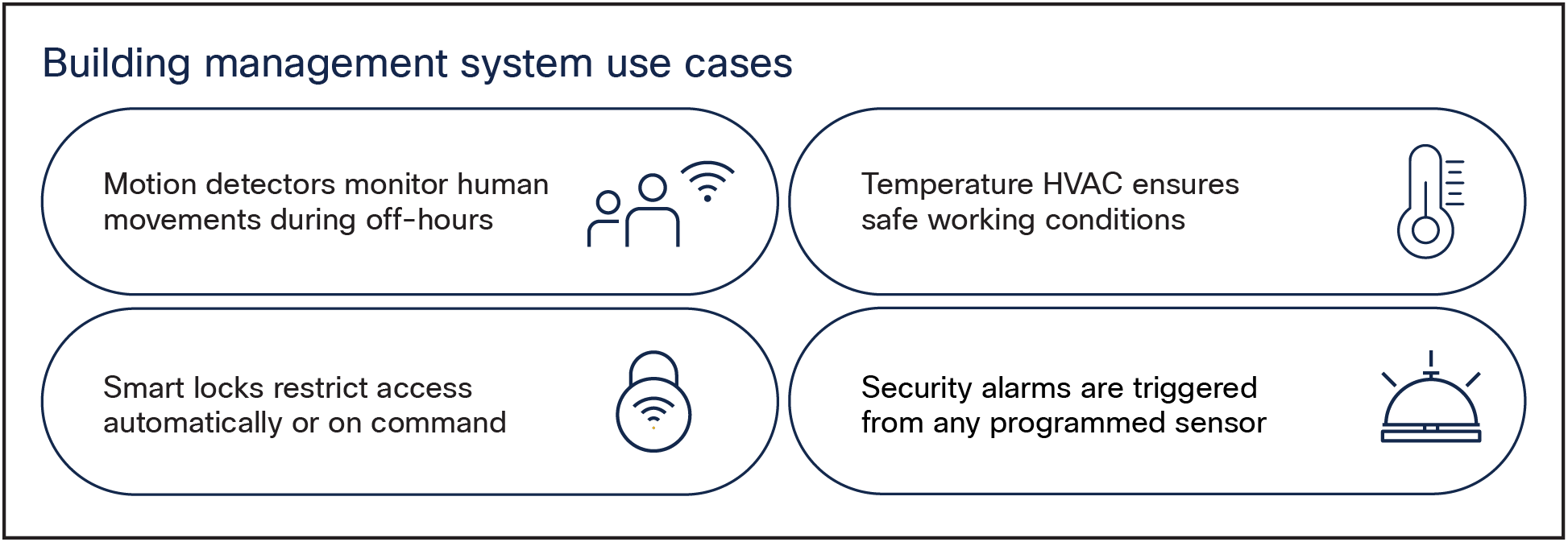
Building management system use cases
Use case 3: Retail stores
Background: The CEO of a large retail chain that directly competes with e-commerce platforms such as Amazon is seeking ways to reduce overhead.
Pain points: There is no way for an in-store retailer to compete with the flexible management of an e-commerce platform. Tasks such as changing the prices of items, helping customers locate items in-store, and even showing the availability of specific items all require significantly higher overhead in a physical store than online.
How Application Hosting addresses the pain points: With Application Hosting, you can create applications that directly communicate with electronic shelf labels (ESLs). ESLs are used in place of standard price tags and enable in-store retailers to update item prices remotely from a computer, and to discover the availability and physical location of any item in the store through a web or mobile application.
Cisco has partnered with an ESL vendor, SES-imagotag, to create this exact IoT ESL application. This solution has saved our customers both time and money through effective retail store management.
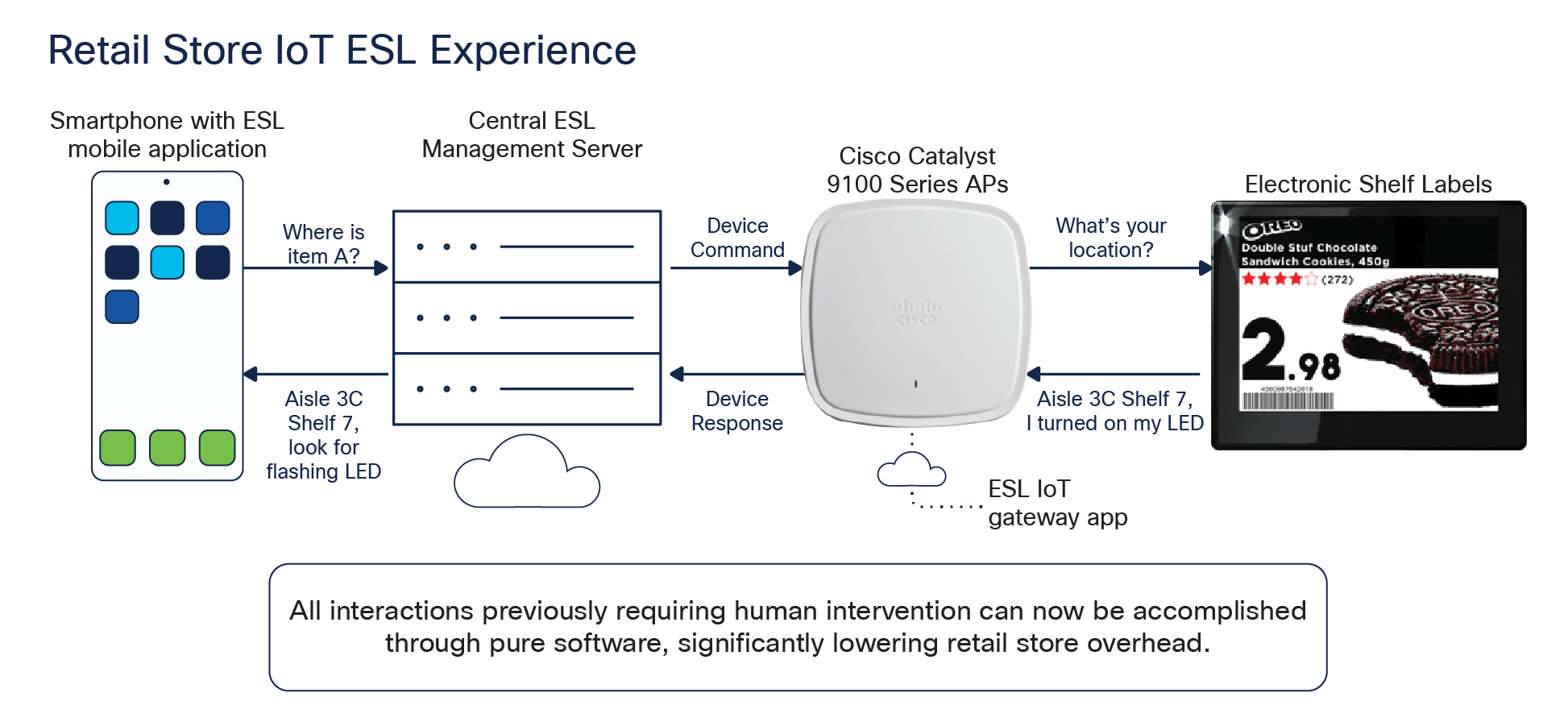
User and store management experience leverage IoT ESLs
To further understand how a typical SES-imagotag solution is deployed throughout retail stores, refer to the figure below.
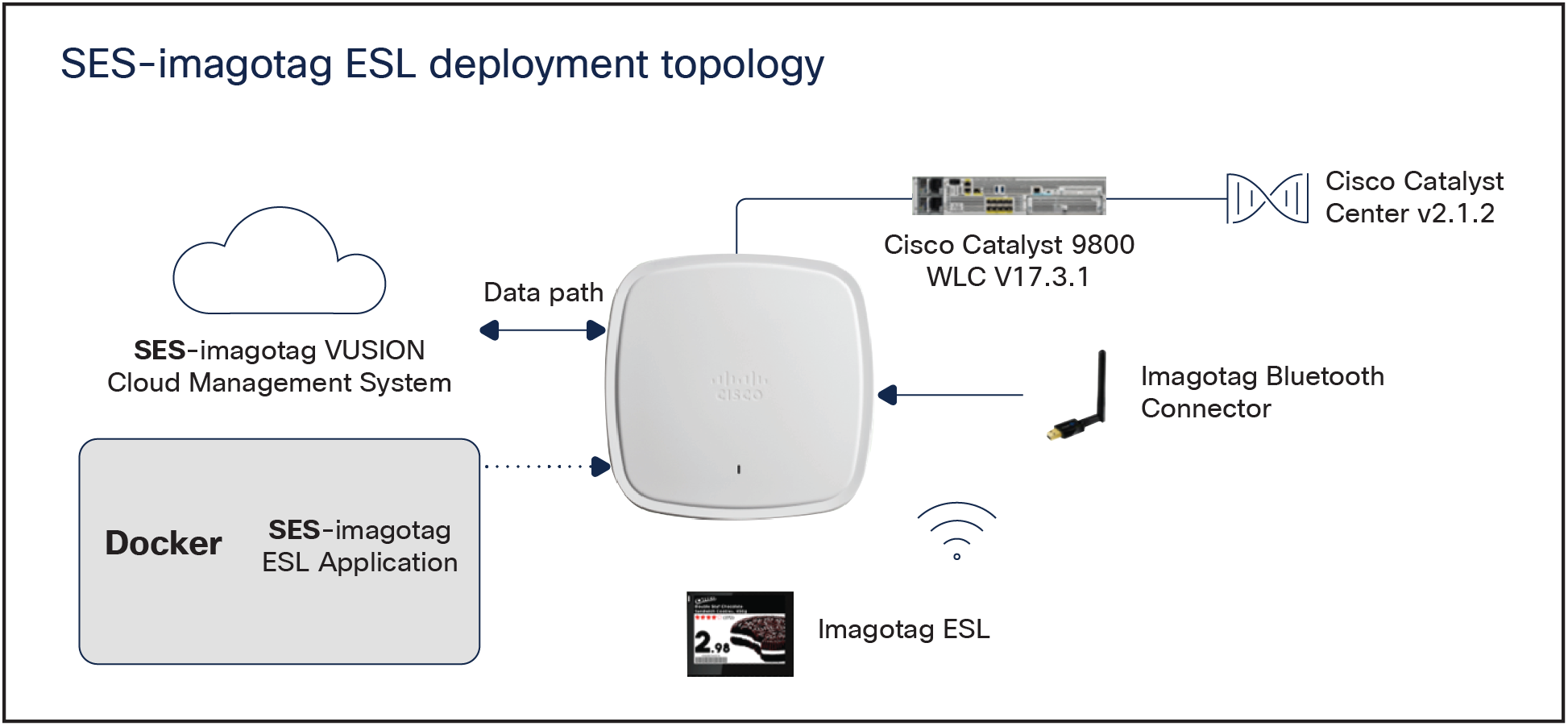
Cisco and SES-imagotag ESL deployment
At the same time that Cisco wireless networks have extended their reach to every corner of the world, the IoT is becoming a part of all aspects of our lives. With smart IoT devices already making their way into ordinary households in forms such as voice control technology, automated temperature regulation, and mobile-controlled security enforcement, we can expect bigger and better use cases in the years to come. Cisco’s Application Hosting on Catalyst Access Points can help you be part of this technological revolution that is changing the world.
Table 1. Matrix of supported software and hardware
| Cisco IOS® XE WLC release |
Cisco Catalyst Center release |
| 17.3.1 and above |
2.1.2.0 and above |
| Access point product ID |
OS type |
WLC product ID |
OS type |
| 9105AXI |
AP-COS |
C9800-CL |
Cisco IOS XE |
| C9105AXW |
AP-COS |
C9800-L |
Cisco IOS XE |
| C9115AX |
AP-COS |
C9800-40 |
Cisco IOS XE |
| C9117AX |
AP-COS |
C9800-80 |
Cisco IOS XE |
| C9120AX |
AP-COS |
|
|
| C9130AX |
AP-COS |
|
|
| C9136I |
AP-COS |
|
|
| CW9162I |
AP-COS |
|
|
| CW9164I |
AP-COS |
|
|
| CW9166I |
AP-COS |
|
|
| CW9166D1 |
AP-COS |
|
|
All Cisco Catalyst Center (formerly Cisco DNA Center) guides
IOx application guides
● Application Hosting on Cisco Catalyst Access Points: https://developer.cisco.com/docs/app-hosting-ap/
● Introduction to IOx: https://developer.cisco.com/docs/iox/#!introduction-to-iox/what-is-iox
● Ioxclient Reference: https://developer.cisco.com/docs/iox/#!what-is-ioxclient
● Tutorial: Build Sample Docker Type IOx App Using Docker Toolchain: https://developer.cisco.com/docs/iox/#!tutorial-build-sample-docker-type-iox-app-using-docker-toolchain/tutorial-build-sample-docker-type-iox-app-using-docker-toolchain
Application Hosting video guides
● The Internet of Things – Application Hosting Overview and Use Cases
◦ https://www.youtube.com/watch?v=ZDRkKOTLat8&ab_channel=CiscoWLAN
● The Internet of Things – Application Hosting Deployment and Technical Deep Dive
◦ https://www.youtube.com/watch?v=0u3FGlRrdhU&ab_channel=CiscoWLAN
Americas Headquarters
Cisco Systems, Inc. 170 West Tasman Drive
San Jose, CA 95134-1706 USA
Tel: 408 526-4000 800
553-NETS (6387)